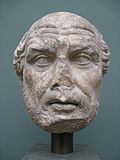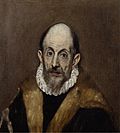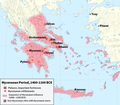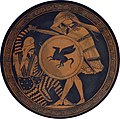Satellite image of Thera, November 21, 2000. The
bay in the center of the island is the
caldera created by the Minoan eruption.
The Minoan eruption volcanic eruption that devastated the Aegean island of Thera (also called Santorini) circa 1600 BC. It destroyed the Minoan settlement at Akrotiri , as well as communities and agricultural areas on nearby islands and the coast of Crete with subsequent earthquakes and tsunamis . With a Volcanic Explosivity Index (VEI) of 7, it resulted in the ejection of approximately 28–41 km3 (6.7–9.8 cu mi) of dense-rock equivalent (DRE), the eruption was one of the largest volcanic events in human history . Because tephra from the Minoan eruption serves as a marker horizon in nearly all archaeological sites in the Eastern Mediterranean, its precise date is of high importance and has been fiercely debated among archaeologists and volcanologists for decades, without coming to a definite conclusion.
Although there are no clear ancient records of the eruption, its plume and volcanic lightning may have been described in the Egyptian Tempest Stele . The Chinese Bamboo Annals Shang dynasty , which may have been a consequence of volcanic winter (similar to 1816, the Year Without a Summer , after the 1815 eruption of Mount Tambora ). (Full article...
The following are images from various Greece-related articles on Wikipedia.
Image 2 The socialist prime minister
Andreas Papandreou (from
History of Greece )
Image 3 Greek Resistance cavalry during the Axis occupation (from
History of Greece )
Image 4 Shards of pottery vases on the street, after being thrown from the windows of nearby houses. A
Holy Saturday tradition in
Corfu . (from
Culture of Greece )
Image 5 Aristarchus of Samos was the first known individual to propose a
heliocentric system , in the 3rd century BC (from
Culture of Greece )
Image 6 The landing of Greek troops in
Kavala during the Balkan Wars (from
History of Greece )
Image 8 Mycenaean Greece,
c. 1400–1100 BC. (from
History of Greece )
Image 9 Proto-Greek linguistic area according to linguist
Vladimir I. Georgiev . (from
History of Greece )
Image 11 The I Battalion of the
Army of National Defence marches on its way to the front, 1916. Greece joined the Allies in summer 1917. (from
History of Greece )
Image 13 Mosaic in the
Hosios Loukas (
Distomo-Arachova-Antikyra , Greece), circa 10th century AD (from
Culture of Greece )
Image 14 Köppen climate classification of Greece (from
Geography of Greece )
Image 15 The
Temple of Hephaestus in
Athens is the best-preserved of all ancient Greek temples. (from
Culture of Greece )
Image 16 The
Little Metropolis (
Athens ), 9th–13th century, unknown architect (from
Culture of Greece )
Image 17 Our Lady of Tinos , the major Marian shrine in Greece (from
Culture of Greece )
Image 19 Exterior view of
Hosios Loukas monastery, artistic example of the
Macedonian Renaissance (from
History of Greece )
Image 21 The ancient theatre of
Dodona (from
History of Greece )
Image 22 Traditional flag used from 1769 to the War of Independence (from
Culture of Greece )
Image 23 Archery matches in
Panathenaic Stadium during the 2004 Olympics. (from
Culture of Greece )
Image 24 A map of Greater Greece after the
Treaty of Sèvres , when the
Megali Idea seemed close to fulfillment, featuring
Eleftherios Venizelos . (from
History of Greece )
Image 25 The
Battle of Navarino , in October 1827, marked the effective end of Ottoman rule in Greece. (from
History of Greece )
Image 26 The most famous artist born in Greece was probably Doménikos Theotokópoulos, better known as
El Greco (
The Greek ) in Spain. He did most of his painting there during the late 1500s and early 1600s. (from
Culture of Greece )
Image 27 Greek cavalry attacking during the
Greco-Turkish War (1919–1922) . (from
History of Greece )
Image 28 A bottle of
retsina (from
Culture of Greece )
Image 29 Depiction of the
Battle of Corinth (146 BC) on the last day before Roman legions looted and burned the city of
Corinth .
The last day on Corinth ,
Tony Robert-Fleury , 1870. (from
History of Greece )
Image 30 Part of the Byzantine
Walls of Thessaloniki (from
History of Greece )
Image 31 A page from a 16th-century edition of the 10th century Byzantine
encyclopaedia of the ancient Mediterranean world, the
Suda . (from
Culture of Greece )
Image 33 Terracotta
kylix that depicts a man holding a
lyre , circa 480 BC, in the
Metropolitan Museum of Art (New York City) (from
Culture of Greece )
Image 34 The territorial evolution of
Kingdom of Greece until 1947 (from
History of Greece )
Image 37 Topographic map of Greece (from
Geography of Greece )
Image 38 Organization and military bases of the Communist led "
Democratic Army ", as well as entry routes to Greece. (from
History of Greece )
Image 39 Mikis Theodorakis , popular composer and songwriter, introduced the
bouzouki into the mainstream culture. (from
Culture of Greece )
Image 40 Overview of the campus of the
Aristotle University of Thessaloniki , the largest university in Greece and the Balkans (from
Culture of Greece )
Image 41 The
Parthenon is an enduring symbol of
ancient Greece and the
Athenian democracy . It is regarded as one of the world's greatest cultural monuments. (from
Culture of Greece )
Image 42 Traditional Greek
taverna , integral part of Greek culture and cuisine. (from
Culture of Greece )
Image 43 Map of earthquakes in Greece and adjacent countries 1900–2017 (from
Geography of Greece )
Image 44 Alexander the Great also known as Alexander III, king of Macedon, was one of the most successful military commanders in history. (from
Culture of Greece )
Image 45 The division of the
Byzantine Empire after the
Fourth Crusade . (from
History of Greece )
Image 46 Members of the
National Organisation of Youth (EON) salute in presence of dictator
Metaxas (1938) (from
History of Greece )
Image 47 Late 4th century AD "Mosaic of the Musicians" with
hydraulis ,
aulos , and
lyre from a Byzantine villa in
Maryamin ,
Syria (from
Culture of Greece )
Image 49 Protest against the junta by Greek political exiles in Germany, 1967 (from
History of Greece )
Image 50 Greece's cities, main towns, main rivers, islands and selected archaeological sites. (from
Geography of Greece )
Image 51 Restored North Entrance with charging bull fresco of the
Palace of Knossos (
Crete ), with some Minoan colourful columns (from
Culture of Greece )
Image 53 The major
Hellenistic realms included the
Diadoch kingdoms :
Also shown on the map:
The orange areas were often in dispute after 281 BC. The
Attalid kingdom occupied some of this area. Not shown:
Indo-Greek Kingdom . (from
History of Greece )
Image 54 Nafplio , the first capital of independent Greece during the governance of
Ioannis Kapodistrias (from
History of Greece )
Image 55 The ancient theatre of
Epidaurus continues to be used for staging ancient Greek plays. (from
Culture of Greece )
Image 56 Map of the
Delian League ("Athenian Empire or Alliance") in 431 BC, just prior to the
Peloponnesian War . (from
History of Greece )
Image 57 Georgios Tsolakoglou with
Wehrmacht officers arrives at Macedonia Hall of
Anatolia College in Thessaloniki, to sign the surrender (April 1941) (from
History of Greece )
Image 59 Mosaic from
Daphni Monastery (ca. 1100) (from
Culture of Greece )
Image 60 Nikos Kazantzakis , one of the most prominent modern Greek writers (from
Culture of Greece )
Image 61 View of the Roman Odeon of
Patras (from
History of Greece )
Image 64 Clashes in Athens during the
Dekemvriana events (from
History of Greece )
Image 66 Crete (
NASA photograph) (from
Geography of Greece )
Image 67 The
Temple of Hephaestus on the Agoraios Kolonos Hill (
Athens ,
Greece ), circa 449 BC, unknown architect (from
Culture of Greece )
Image 68 Depiction of the
Greek fire in
John Skylitzes '
Madrid Skylitzes (late 11th century). (from
History of Greece )
Image 70 George I was King of the Hellenes from 1862 to 1913 (from
History of Greece )
Image 71 Bust of
Herodotus in
Stoa of Attalus , one of the earliest nameable historians whose work survives. (from
History of Greece )
Image 72 Proclamation of the Second Hellenic Republic in 1924. Crowds holding placards depicting
Alexandros Papanastasiou ,
Georgios Kondylis and
Alexandros Hatzikyriakos (from
History of Greece )
Image 74 Idealized portrait of
Homer ,
British Museum (from
Culture of Greece )
...that the Greeks were the first to develop an alphabet with vowels ?
...that the Greco-Buddhist art is an artistic manifestation of Greco-Buddhism , a cultural syncretism between the Greek culture and Buddhism, which developed in Central Asia after the conquests of Alexander the Great ?
...that the Rio–Antirrio bridge between the Peloponnese and mainland Greece is the longest cable stayed-suspended deck in Europe ?
...that the country's highest mountain, Mount Olympus was said to be the home of the Greek Gods in ancient Greek religion?
...that the Olympic Games originated in Greece 3000 years ago, and that the 1st games of the modern Olympics were held in Greece in 1896, as a revival of the Games?
...that the Greek state comprises only the centre of the ancient Greek world , which comprised also Southern Italy, the coastal areas of modern Turkey and the Black Sea, as well as some colonies in North Africa, Southern France and Spain?
...that even though the modern Greek state was established in 1832, some areas of Greece were not liberated until after the Balkan Wars and WW2 ?
Overview Regions
Central Greece (Aetolia-Acarnania (Aetolia , Acarnania ), Attica , Boeotia , Euboea , Evrytania , Phocis , Phthiotis , Saronic Islands )Crete (Chania , Heraklion , Rethymno , Lasithi )Cyclades (Andros , Delos , Kea , Kythnos , Milos , Mykonos , Naxos , Paros , Santorini , Syros , Tinos )Dodecanese (Agathonisi , Astypalaia , Chalki , Kalymnos , Karpathos , Kasos , Kos , Leipsoi , Leros , Nisyros , Patmos , Rhodes , Symi , Tilos , Kastellorizo )Epirus (Arta , Ioannina , Preveza , Thesprotia )Ionian Islands (Corfu , Ithaca , Kefalonia , Kythira , Lefkada , Paxi , Zakynthos )Macedonia (Chalkidiki , Drama , Florina , Grevena , Imathia , Kastoria , Kavala , Kilkis , Kozani , Pella , Pieria , Serres , Thasos , Thessaloniki )North Aegean islands (Chios , Ikaria , Lemnos , Lesbos , Samos )Peloponnese (Arcadia , Argolis , Corinthia , Laconia , Messenia , Achaea , Elis )Thessaly (Karditsa , Larissa , Magnesia , Trikala , Sporades )Thrace (Evros , Rhodope , Xanthi ) Terrain Water Environment
Society
Demographics Culture
Anastenaria Caryatid Clean Monday Concept of kingship Dress (Chiton , Chlamys , Exomis , Fustanella , Himation , Mariner's cap , Peplos , Perizoma , Tsarouchi , Vraka )Eastern Party Festivals Folklore Greek East and Latin West Greektown Hellenization Hospitality Carols (Christmas , New Year's , Theophany's )
Mangas Mountza Naming customs Paideia Philhellenism and Hellenophobia Plate smashing Philosophy Public holidays (Independence Day , Ohi Day )Rouketopolemos Souliotic songs Theophany Tsiknopempti Units of measurement Worry beads Art Cuisine
Breads (Daktyla , Kritsini , Lagana , Paximadi , Tsoureki )
Desserts (Diples , Halva , Koulourakia , Kourabiedes , Loukoumades , Melomakarona , Pasteli , Spoon sweets , Vasilopita )
List of dishes Drinks (Mastika , Metaxa , Ouzo , Rakomelo , Sideritis , Tentura , Tsipouro , Tsikoudia , Frappé coffee )
Cheeses (Anthotyros , Feta , Graviera , Kasseri , Kefalotyri , Ladotyri , Manouri , Metsovone , Mizithra )Filo (Amygdalopita , Bougatsa , Galaktoboureko , Karydopita , Spanakopita , Tiropita )Greek salad (Dakos )Meze Pasta (Gogges , Flomaria , Hilopites )
Restaurants (Kafenio , Ouzeri , Taverna )Sauces (Skordalia , Taramosalata , Tirokafteri , Tzatziki )
Souvlaki Varieties (Heptanesean , Cretan , Epirote , Macedonian )
Wine (Agiorgitiko , Aidini , Assyrtiko , Athiri , Kotsifali , Lesbian , Limnio , Mavrodafni , Mandilaria , Malagousia , Malvasia , Moschofilero , Retsina , Robola , Savatiano , Vilana , Xinomavro ) Languages
Greek alphabet (History , Orthography , Diacritics , Braille , Cyrillization , Romanization (Greeklish ) and numerals Greek language (Demotic , Katharevousa ) and dialects (Cappadocian , Cretan , Cypriot , Greco-Australian , Maniot , Pontic , Tsakonian , Yevanic )Greek Sign Language History (Mycenaean Greek , Ancient Greek , Koine Greek , Medieval Greek , Modern Greek )Literature (Ancient , Medieval , Modern )Minority languages (Albanian language (Arvanitika ), Aromanian , Balkan Romani , Bulgarian , Ladino , Macedonian , Megleno-Romanian , Turkish )Proverbs Words for love Media Music
Church music Dances (Ai Georgis , Angaliastos , Antikristos , Ballos , Dionysiakos , Fisounis , Gaitanaki , Geranos , Hasapiko , Ikariotikos , Kalamatianos , Kangeli , Kastorianos , Kerkiraikos , Koftos , Pidikhtos , Leventikos , Maniatikos , Metsovitikos , Ntames , Palamakia , Partalos , Pentozali , Proskinitos , Pyrrhichios , Rougatsiarikos , Sirtaki , Sousta , Syrtos , Trata , Tsakonikos , Tsamikos , Zeibekiko , Zervos )Éntekhno Folk music (Cretan , Epirote , Heptanesian , Macedonian , Nisiotika , Peloponnesian , Pontic , Thessalian , Thracian )Hip Hop Ionian School Laïko (Skyladiko )Musical instruments (Askomandoura , Aulos , Bouzouki , Byzantine lyra (Cretan , Macedonian , Politiki , Pontic ), Crotala , Floghera , Gaida , Harp , Laouto , Lyre , Organo , Pan flute , Phorminx , Psaltery , Salpinx , Santouri , Souravli , Tambouras , Tambourine , Trigono , Tsampouna , Tympano , Zilia )Rebetiko Rock (Punk ) Religion and lore
Ancient religion (Origins , Modern Revival )Aerico Atheism Buddhism Catholicism Drosoulites Eastern Orthodox Church (Timeline: Antiquity , Early Middle Ages , Late Middle Ages , Early Modern Era , 19th century , Early 20th century , Late 20th century , Contemporary )Fairy tales Gello Greek Orthodox Church (Ecumenical Patriarchate of Constantinople , Church of Greece , Flag )Greek Old Calendarists Hinduism Hypertimos Islam Judaism (History )Kallikantzaros Lamia Mormo Mount Athos Mythology (Primordial deities , Titans , Twelve Olympians , Heracles , Odysseus , Jason , Oedipus , Perseus , Daedalus , Orpheus , Theseus , Bellerephon , Satyr , Centaur )Nymph Protestantism Psychai Sikhism Thymiaterion Name days Vrykolakas Wayside shrine Sport Symbols
Articles related to Greece
1896 Summer Olympics , Alcibiades , Archimedes , Aspasia , Attalus I , Basiliscus , Battle of Dyrrhachium (1081) , Battle of Greece , Byzantine Empire , Byzantine navy , Cleomenean War , Corinthian War , Cretan War (205–200 BC) , Demosthenes , Diocletian , El Greco , Epaminondas , Euclidean algorithm , George I of Greece , Greece runestones , Greek mythology , Hippocrates , Manuel I Komnenos , Macedonia (terminology) , Orion (mythology) , Pericles , Philitas of Cos , Problem of Apollonius , Stamata Revithi , Rhodes blood libel , Slavery in ancient Greece , The Battle of Alexander at Issus , The Penelopiad , Theramenes , Thrasybulus
Battle of Artemisium ,
Battle of Thermopylae ,
Battle of Kalavrye ,
Battle of Marathon ,
Battle of Salamis ,
Byzantine civil war of 1341–47 ,
Byzantine–Sasanian War of 602–628 ,
First Macedonian War ,
John Kourkouas ,
Yannis Makriyannis ,
Sviatoslav's invasion of Bulgaria ,
Vikos–Aoös National Park
Category puzzle Select [►] to view subcategories
Literature and philosophy
Homer In Greece, from ancient times down to the present, has been produced countless world-famous poetry in addition to philosophers like Socrates , Plato and Aristotle and historians like Herodotus and Thucydides . Notable figures of modern Greek literature include Odysseas Elytis and Constantine Cavafy .
Sing, O goddess, the anger of Achilles son of Peleus, that brought countless ills upon the Achaeans. Many a brave soul did it send hurrying down to Hades, and many a hero did it yield a prey to dogs and vultures, for so were the counsels of Zeus fulfilled from the day on which the son of Atreus, king of men, and great Achilles, first fell out with one another.
Greek art began in the Cycladic and Minoan prehistorical civilization. The art of ancient Greece has exercised an enormous influence on the culture of many countries from ancient times until the present, particularly in the areas of sculpture and architecture. In the West, the art of the Roman Empire was largely derived from Greek models. In the East, Alexander the Great's conquests initiated several centuries of exchange between Greek, Central Asian and Indian cultures. During the Renaissance , the humanist aesthetic and the high technical standards of Greek art inspired generations of European artists.Read more...
You are invited to participate in WikiProject Greece , a task force dedicated to developing and improving articles about Greece .
Music
Maria Callas
Cinema
Angelopoulos
Architecture
Phidias
Sculpture
Painting
El Greco
Science
Caratheodory
Philosophy
Aristotle
Literature
Cavafy
Politics
Eleftherios Venizelos
A short video of the main sites at the ancient sanctuary of
Delphi in
Central Greece . Delphi was considered to be the center of the world by the Greeks and the most important oracle in the Greek world.













































































































